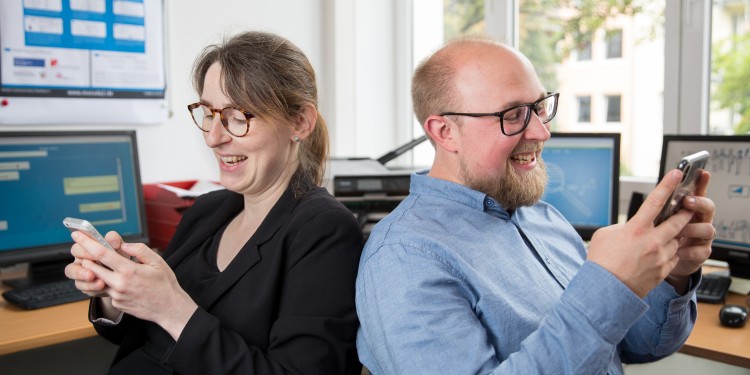
More than just a goodnight message
"You missed something yesterday. Tim fell in our pool!"
"Now really @Tim?? Thought you didn't want to drink anything"?
"Haha tim :D"
What sounds like banal chit-chat among a group of young people about what happened at a party is of great interest to linguists at the Institute of German Language and Literature at the University of Münster. By examining such chats, for example, Dr. Katharina König found out that users are inadvertently made figures of fun and that emojis play a decisive role in distinguishing between the processes of laughing with or laughing at someone. How and why do we use messaging services such as Facebook, WhatsApp and so on? For linguists, these services represent highly interesting source material for studies. For this reason, and in collaboration with the University of Duisburg-Essen and the University of Hamburg, the experts at Münster University have developed the ‘Mobile Communication Database’ or MoCoDa for short. The database archives chats from a variety of messaging services and makes them available for research and teaching at universities.
The uploading process is simple: anyone can upload his or her chats anytime via the MoCoDa website, which has been online since 2017. WhatsApp chats, for example, can be transferred to the database by means of an export function. A technical assistant helps in editing the chats and, in particular, in making them anonymous to rule out any possibility of tracing the chats back to actual people. Finally, information on the people involved is recorded – for example age, gender, their relationship to each other, and the situation in which the chat developed. It is in collecting these so-called metadata that the database really shows it usefulness. “The metadata help us to study the functions of the individual forms of language used in the chats,” explains Dr. Marcel Fladrich, one of the founders who set up the project. “As a result, for example, we know that men send fewer emojis expressing feelings, when chatting to other men, than women do when they chat only with other women. In chats involving both sexes, however, this ratio is inverted,” he adds.
What further features does the platform have? In contrast to other databases for archiving electronic text messages, it is designed to collect data continually. Also, not only the developers can access it – all researchers, who are engaged in studying everyday digital communication, can use the MoCoDa. “In this form, the platform is unique in Europe,” says Marcel Fladrich. “Because data are being permanently collected, we can also recognize the change processes taking place in communication. Also, the database is always up to date as a result of constant new chats being uploaded to it.”
The platform currently comprises about 334 chats with around 27.000 messages involving 1.864 people. The researchers do depend, though, on as many users as possible voluntarily making their chats available in the future too. The students at the Institute of German Language and Literature also profit from this data pool. As part of the university curriculum, they gain experience in seminars on media language in uploading and evaluating the data contained in the MoCoDa. “In understanding the uploading process, the students learn which data were collected and which questions they can find answers to by using the database,” says Katharina König. This seems to inspire the students: many of them write their theses with, or about, the MoCoDa – for example, on regional differences in the use of WhatsApp.
Language researchers at Münster University already took their first steps leading up to the current database in 2011, when they built up an SMS database. Working together with students, they developed a concept enabling material to be collected for research work on everyday communication via SMS. However, the emergence of new messaging services such as Facebook and WhatsApp made a big change to the way digital communication took place. “In the SMS database it was simply no longer possible to include emojis or the quote function, group chats or images and audio messages that were sent – and this is what ultimately led to the MoCoDa being set up,” explains Marcel Fladrich.
But the potential for developing the database even further has not been exhausted by any means. In future, the aim is to make it possible for the emojis which are currently shown in Unicode – so always exactly the same – to be shown on an iPhone or Android smartphone too, corresponding to their different displays. Because, as Katharina König explains, these different displays can lead to misunderstandings in communication, making an examination of them suitably relevant. “Although looking after the database is a lot of work,” adds Marcel Fladrich, “it’s certainly worth carrying on with the project because we don’t expect the use of messaging services to decrease – indeed, they will continue to have a strong influence on our lives and on everyday communication.”
For many people it is perfectly normal that this communication should go on until the end of the day. Chats such as the following are typical of many people:
"Must sleep now, have to go to uni at 10"
"All right. Sleep tight and dream about me :*"
"I'm sure. good night sweetheart see you tomorrow"
The researchers have found out that sending a goodnight message in this way is a classic for student couples living apart – for those, at least, who want to work at their relationship and have no opportunity in the evening to say goodnight to their partner in person …
Author: Jana Haack
This article was first published in the University newspaper wissen|leben No. 7, November 2019.
